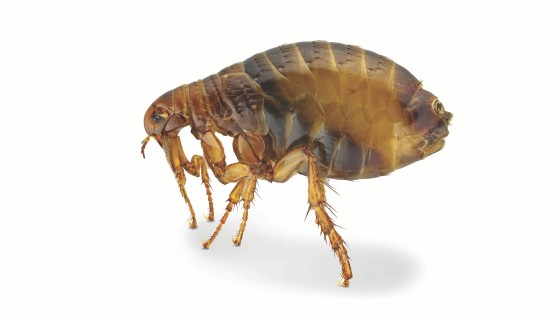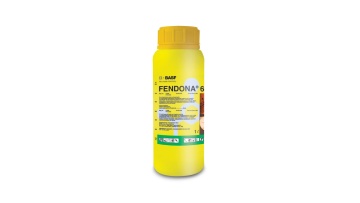Fleas
A concern with fleas is their ability to transmit disease organisms. This ability is enhanced by their promiscuous feeding habits as they move from one host species to another. For example, the cat flea, Ctenocephalides felis, readily attacks humans, dogs, rats and foxes. The human flea, Pulex irritans, can be found on dogs, rats, pigs, mice, badgers, deer and foxes.
Infestation by fleas may also cause severe inflammation of the skin and intense itching.
The potentially long pupal stage, and the fact that adult fleas can live without food for remarkably long periods, accounts for the fact that people may enter a house after it has been unoccupied by humans or pets for months, yet be rapidly and severely attacked by fleas.
Fleas most often bite people about the legs and ankles, and there are usually 2 or 3 bites in a row. The bites are felt immediately, but tend to become increasingly irritating, and are frequently sore for as much as a week.
Human Flea
Latin name: | Pulex irritans |
Length: | 2 mm |
Colour & description: | Adults are small, black to brownish-black insects and are wingless. They are laterally compressed and they have stout, spiny legs, adapted for leaping. Have short, 3-jointed, antennae that fit into depressions along the sides of the head. Have piercing-sucking mouthparts developed for feeding on blood. |
Habits & habitat: | Are parasitic as adults and are found on dogs, rats, pigs, badgers etc. Eggs are laid on the body but are often detached. Larvae are usually found on floor or bedding of the host and often feed off the faeces of adult fleas. The adult can remain in the cocoon for long periods until vibrations indicating the presence of a possible host stimulate it to emerge and become active. |
Life cycle: | 5 weeks – 1 year dependant on conditions |
Reproduction rate: | Female fleas lay 4 to 8 eggs after each blood meal and may lay several hundred eggs in their lifetime. These may hatch in 2 – 3 days and given an adequate supply of food, larvae should pupate and weave a silken cocoon within 3 - 4 weeks, after completing 3 larval stages. Under favourable conditions, the adult emerges in a week or two, but under adverse conditions, the pupal period may be prolonged to as much as a year. |
Cat flea
Latin name: | Ctenocephalides felis |
Length: | 2 mm |
Colour & description: | Adults are small, brown insects and are wingless. They are laterally compressed and they have stout, spiny legs, adapted for leaping. Have piercing-sucking mouthparts developed for feeding on blood. |
Habits & habitat: | Are parasitic as adults and are found on dogs, cats, rats, foxes etc. Eggs are laid on the body but are often detached. Larvae are usually found on floor or bedding of the host and often feed off the faeces of adult fleas. The adult can remain in the cocoon for long periods until vibrations indicating the presence of a possible host stimulate it to emerge and become active. |
Life cycle: | 5 weeks – 1 year dependant on conditions |
Reproduction rate: | Female fleas lay 4 to 8 eggs after each blood meal and may lay several hundred eggs in their lifetime. These may hatch in 2 – 3 days and given an adequate supply of food, larvae should pupate and weave a silken cocoon within 3 - 4 weeks, after completing 3 larval stages. Under favorable conditions, the adult emerges in a week or two, but under adverse conditions, the pupal period may be prolonged to as much as a year. |

Flea larvae require 50% relative humidity or greater for survival. They survive best outdoors in shady, moist areas during warm months in moderate climates. Indoors, they do best in protected areas, such as within carpet fibers, beneath cushions of upholstered furniture, cracks in wood floors or pet bedding.
As the larvae progress through their third instar, they spin silk cocoons for pupation. The cocoons, which incorporate dirt, lint and other debris, are hard to detect and also protect pupae from pesticide penetration. The pupal stage averages about 7 to 14 days, but some pre-emerged adult fleas remain in the protective cocoon for as long as a year waiting for a host-presence stimulus to trigger emergence.
Stimuli can include vibrations, warmth, carbon dioxide and pressure. Emerging adults begin feeding once they have found a host, usually within seconds. They commonly mate while on the host within a matter of hours and the female can begin laying eggs within 48 hours. Adults usually remain on the host and may live for one to four weeks.
Identification
When attempting to identify flea species the white sock method may be helpful. Simply put on a pair of white socks, pulling them up over the cuffs of your trouser legs, and walk around the areas suspected of harboring fleas. Fleas will quickly jump onto the socks where they can be captured for identification.


